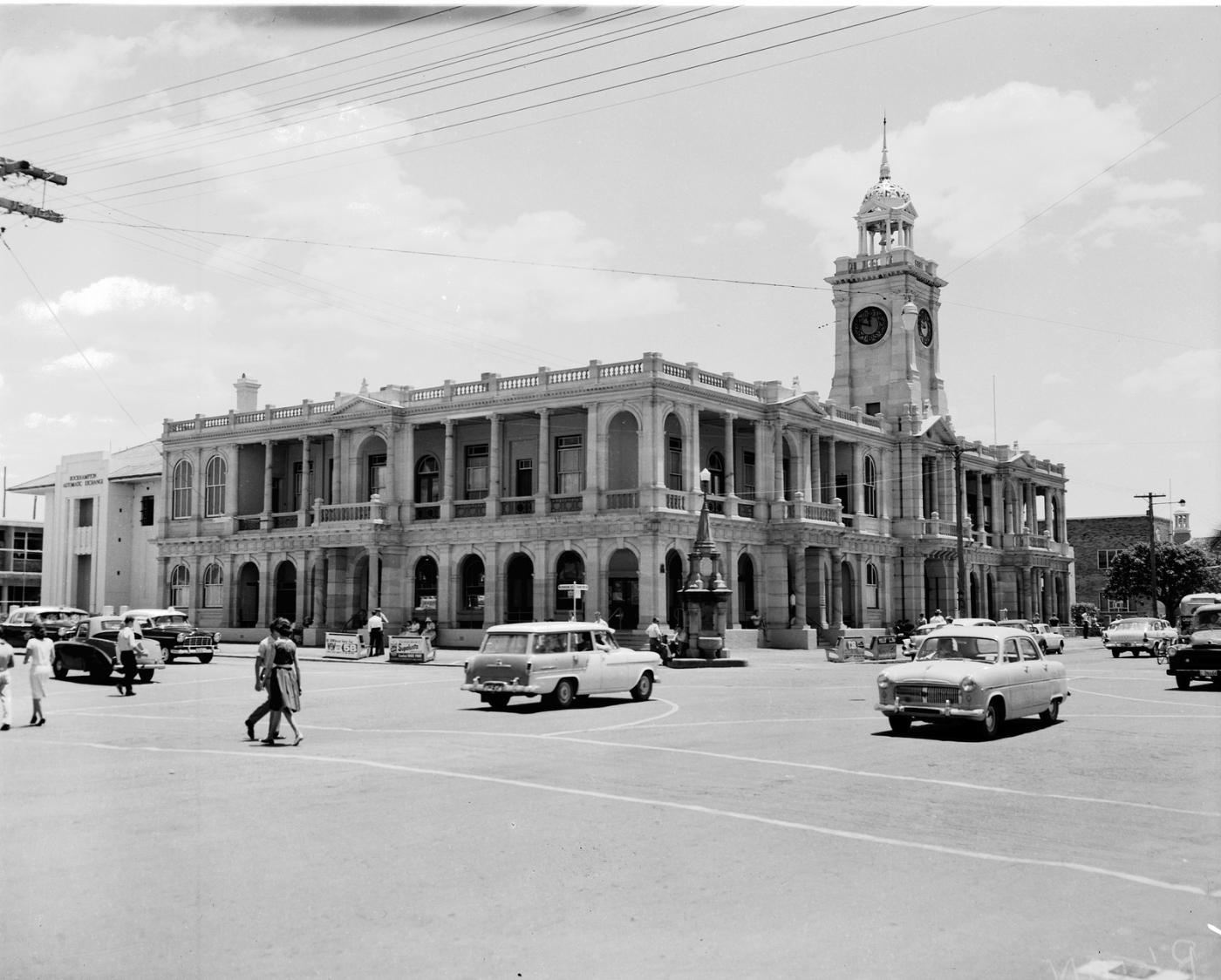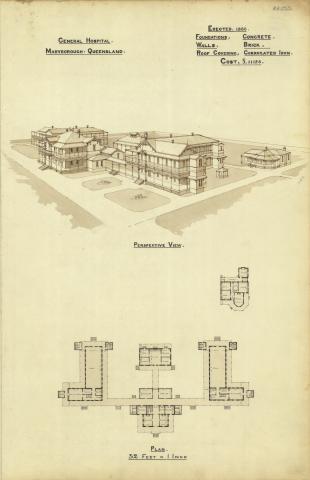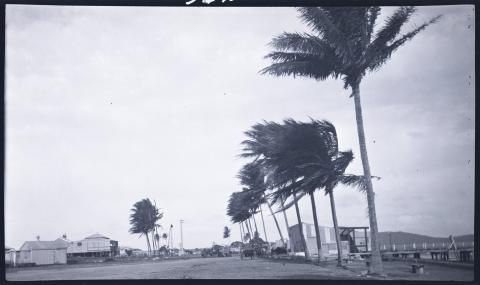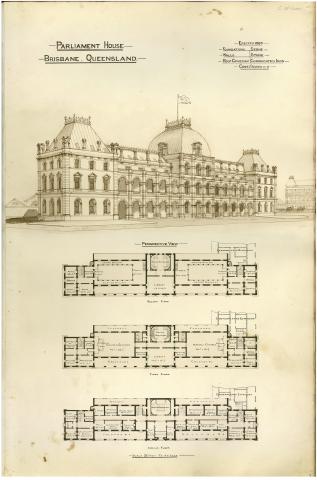
- News of the day
-
Telegraph, Saturday 20 February 1886, page 4
Rockhampton Post Office.
The acting Colonial Architect has nearly completed plans for a new post and telegraph building, with a handsome tower for Rockhampton. It is felt that the present structure is far too small to meet the increased requirements of a growing town like this is, and accordingly these plans of an extensive, commodious, and very imposing and attractive building have been prepared, and they will be shortly submitted for the approval of the Government.
- Background
-
This grand two-storeyed brick post office with sandstone facing was erected in 1892 for the Queensland Post and Telegraph Department. It was designed in the office of Colonial Architect George Connolly, and was built by Dennis Kellaher for £14 368. Situated at the corner of Denham and East Streets, it was the sixth post office to be established in Rockhampton after a succession of temporary and superseded post offices.
An unofficial post office was established at Rockhampton in 1858 at a store in Little Quay Street and in 1861 was relocated to a chemist shop. In December 1862, Postmaster General Thomas Lodge Murray-Prior recommended the establishment of an official post office in Rockhampton. By 1863 the first official Postmaster had been appointed and a temporary wooden post office building was constructed on the present post office site between 1863 and 1865.
During this period Rockhampton's postal services had expanded greatly. In 1865 Rockhampton was linked with Brisbane, via the inland route, through Taroom, Hawkwood, Dalby, Toowoomba and Ipswich and by the mid 1860s most outposts in Central Queensland were in touch with Rockhampton through fortnightly or weekly mail services. On 20 November 1864 a telegraph line was opened between Rockhampton and Gladstone and the first telegraph office was opened in a chemist shop.
The makeshift wooden post office was replaced in 1866 by an ornate two-storeyed brick building with decorative wooden verandahs. This building was designed by Colonial Architect Charles Tiffin but was originally planned for Maryborough. Due to the cost of materials exceeding the budget for the post office originally planned for Rockhampton, the plans for the post offices were swapped. The two buildings were designed concurrently by Tiffin.
In 1876, the Rockhampton Post Office had processed more than a quarter of a million ordinary letters and fifteen thousand registered letters as well as providing money order and savings bank services.
From 1879, postal and telegraph services were amalgamated under the Queensland Post and Telegraph Department, but the two services continued to operate separately in Rockhampton, with both a Post and Telegraph Master. In 1883 a new telegraph office was erected next to the old post office. At this time Rockhampton was the main telegraph traffic centre for central and north Queensland and was the largest telegraph office outside Brisbane.
In 1881 telephones were introduced to Rockhampton with the first telephone exchange opening in April 1884 in a low, wooden building behind the telegraph office and next to the old post office facing East Street. By 1886 the old post office of twenty years and the 1883 telegraph office were too small and the Colonial Architect was requested to plan a new building. With the construction of the 1892 Post and Telegraph Office the three buildings which housed Rockhampton's communication network were demolished and a temporary post office was established in the old Court House while construction was taking place.
The present post office was constructed of brick with a facade of sandstone from the nearby Stanwell Quarries. It was constructed by Dennis Kellaher when his tender for £14 368 was accepted as the lowest. Kellaher was also contracted to install the first floor accommodation for the Post and Telegraph Masters for £3579.
The original design of the Post and Telegraph Office was reflective of the separate services of the two departments. The Postal section was located on the corner of Denham and East streets and the Telegraph section was located at the northern end of the building facing East Street. The two were separated by a carriage-way and a clock tower which was installed in September 1894 by the Government Clockmaker. (The clock was made by Gillet and Johnston of Croydon, England, and cost £325.) The first floor was dedicated entirely to accommodation for the Post and Telegraph Masters, each of their apartments situated above their respective sections on the ground floor.
The front wing of the Post Office section was originally divided into rooms for the savings bank and money order office, delivery room and the private letter box office by partitions of cedar with embossed panels. The delivery room of the new Post Office introduced an innovation in customer service by installing a counter in order to hand correspondence to the public instead of the usual method of serving through a small window.
In the three decades leading to the establishment of the 1892 post office, Rockhampton had proved itself a thriving commercial centre due to its position as an official port of entry servicing a vast area of central Queensland. The immense financial boost from the Mt Morgan gold rush in the 1880s further established Rockhampton as a wealthy commercial centre. The grand structure of the Rockhampton Post Office symbolised the prominence of the city during this period and the confidence which was held for its future. Many buildings of similar architectural and aesthetic calibre which were constructed in Rockhampton during this period (eg. Quay Street) were a manifestation of the city's economic wealth. With Federation looming, the establishment of the Rockhampton Post Office was held as a great boon to the advancement of the separationist movement which had long supported a political rivalry with the capital of Brisbane.
Rockhampton was the communication nexus for the developing areas of central and north Queensland and the continuing use of the Rockhampton Post Office for postal services over the last century clearly demonstrates the development of communication technology in one of the most important postal centres of Queensland. While the grand, stone exterior of the post office has remained largely intact, the interior of the building has been altered a number of times to accommodate the changing needs of the postal and telegraph services.
During construction of the post office, parcel post was introduced to Queensland, and one of the first alterations occurred in 1896 to provide more suitable accommodation for the processing of packages. A separate space for parcels was created at the rear of the building with a new public counter accessible through the Denham Street arcade. Another extension was added at this time at the rear of the post office section adjacent to the carriage-way.
Following Federation in 1901, the colonial post and telegraph services were handed over to the Commonwealth Government and the Rockhampton Post Office became the Property of the Post Master General's Department. By 1913, the Telegraph Masters accommodation had been replaced with staff facilities and a telephone switch room which was subsequently expanded in 1921 to cope with the rapidly increasing demand for telephones.
In 1940, the present automatic telephone exchange building was opened enabling the telegraph operating room in the Post and Telegraph Office to be moved upstairs while the dispatch office and public counter remained on the ground floor. By 1945 the Post Master's accommodation on the first floor had been removed for use as offices and the first floor carriage-way had been infilled.
In 1945, the first floor telegraph rooms were updated with new telegraph and phonogram accommodation. Rockhampton was one of the seven original telegraph traffic centres to be equipped in 1947 with an Auxiliary radio channel for use during periods of land line failure.
In 1963 the ground floor carriage way was infilled and a central staircase inserted. A new main entrance was positioned at the former entrance to the carriage-way, under the clock-tower, and an extension was constructed at the rear of the building joining completely the two separate sections of the building.
In 1975, the Australian Post Master General's Office became two separate commissions, Australia Post and Telecom, with telegraphic communications no longer a constituent of the Post Office. The interior of the Post Office was refurbished in 1980 with the exterior maintaining its grand colonnaded facade. In the 1988 the french doors and sash windows which originally opened onto the arcade at the southern end of the building were removed to create arched openings to access a concertina arrangement of private mailboxes. The Rockhampton Post Office ceased functioning as the main post office in Rockhampton in May 1997.
Courtesy of the Queensland Heritage Register.
/150.5135166,-23.3782718,7/450x450@2x.png?access_token=pk.eyJ1IjoicXNhLWRpc2NvLXFsZCIsImEiOiJjamJmdTgyZXEyeWNjMnlxZm8xcmtieHgxIn0.lmT9J5tTPKGuuccQgCVSAg)



